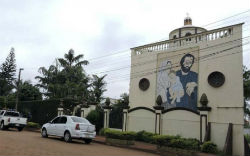A series of recently published photos — showing churches owned by alleged drug traffickers in Paraguay — is a reminder of the sometimes complicated intersection between religion and organized crime in Latin America.
In mid-January, authorities reported that local police officers in eastern Paraguay were accused of stealing over 250 kilos of seized cocaine and handing it over to alleged drug trafficker Clemencio Gonzalez Gimenez, alias “Gringo.” During the investigation into the case, police officials searched Gonzalez’s properties in the province of Amambay, and found a building that some might find surprising — not a nightclub, or even a zoo, but a small church. Photos were originally published by ABC Color and are reprinted by InSight Crime with permission.

This is not the first example of a suspected drug trafficker who decided to build his own church in Paraguay, according to ABC Color. In 2009, the country’s anti-drug agency SENAD found a church (see below) on the property of trafficker Jarvis Chimenes Pavão, who was one of Paraguay’s most wanted criminals before his arrest.

In 2011, the SENAD also discovered a “mini-sanctuary” (below) at the residence of drug trafficker Tomas Rojas Cañete in Ciudad del Este. Authorities raided his property and seized over 100 kilos of cocaine.

InSight Crime Analysis
Drug traffickers who profess to believe in and follow the rules of the Catholic Church often have ulterior motives for practicing their faith, says one expert.
“They [drug traffickers] are mostly looking for divine protection and aren’t concerned with Christianity as an ethical system,” Andrew Chesnut, a professor of religious studies at Virginia Commonwealth University and author of the book “Devoted to Death: Santa Muerte, the Skeleton Saint,” told InSight Crime.
Chesnut noted that in Paraguay’s case — where 90 percent of the population is Catholic — cases in which criminals subscribe to a particular religion “mostly plays out in a Catholic context.”
SEE ALSO: Coverage of Paraguay
But that’s not the case in other parts of Latin America. In Puerto Rico and Colombia, those involved in the drug trafficking underworld are known to practice Santeria — a combination of West African and Roman Catholic beliefs and practices — in belief that it will help them avoid detection from authorities. In Mexico, some locals in the state of Michoacan canonized a founder of criminal group La Familia Michoacana, Nazario Moreno Gonzalez, alias “El Mas Loco,” and built a church to venerate the “narco-saint” after his reported death in 2010 — he later turned up dead following a gun fight with authorities in 2014. The Knights Templar, a splinter group of La Familia Michoacana, has carried on this tradition of quasi-religious mythology by indoctrinating new recruits with an evangelical devotion towards God.

